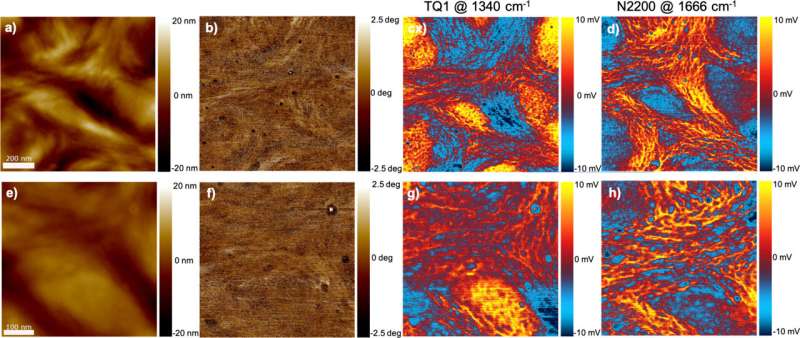Research on organic solar cells has been conducted for a long time. Recent advancements in understanding their molecular structures are now paving the way for the development of highly efficient solar cells.
“By using atomic force microscopy-infrared spectroscopy, AFM-IR, we’ve been able to create clearer images of the morphology or structure of the material,” says Ishita Jalan, postdoc in physical chemistry and main author of a recently published article in ACS Applied Polymer Materials. This structure and how it can be controlled determines the effect of the solar cell.
Efficient solar cells that are cheap to manufacture
The experiments form part of the research on organic solar cells. The idea is to create materials that can conduct electrical current by mixing molecules in a solvent that you spread out in a thin layer, which then is left to dry. Two different kinds of molecules are needed—those that donate electrons and those that accept them.
In the experiments, a small glass plate is coated with a solution and researchers then study the drying process and the formation of a thin polymer film as the solvent evaporates. This provides information on how to control the structure and properties of the active layer of solar cells to achieve the highest possible energy efficiency.
“Conjugated polymers belong to a class of organic semiconductors used in a wide range of optoelectronic applications, such as organic solar cells and organic light-emitting diodes,” says Jalan.
Thin liquid films of two or more conjugated polymers or small molecules are coated from a solution on a substrate. During drying, the solution undergoes a phase separation, forming structures that create a network of donor-rich and acceptor-rich phases. The composition and interconnection of these phases play a crucial role in energy efficiency.
Efficient and environmentally friendly solar cells is part of the solution for eliminating fossil fuel dependency. Currently, solar energy accounts for just a small percent of the human energy consumption worldwide.
However, if we could transform all solar energy that reaches our earth during just one hour into electricity, it would cover the entire planet’s energy consumption for approximately a year. In order to replace other energy sources, we need efficient, environmentally friendly solar cells which are cheap to manufacture.
More information:
Ishita Jalan et al, AFM-IR Spectromicroscopy Unveils Hidden Phase Separation in Polymer–Polymer Blend Films for Photovoltaic Applications, ACS Applied Polymer Materials (2024). DOI: 10.1021/acsapm.4c01883
Provided by
Karlstad University
Citation:
Imaging advance creates clearer picture of organic solar cells’ molecular structure (2024, October 31)
retrieved 31 October 2024
from https://phys.org/news/2024-10-imaging-advance-clearer-picture-solar.html
This document is subject to copyright. Apart from any fair dealing for the purpose of private study or research, no
part may be reproduced without the written permission. The content is provided for information purposes only.

